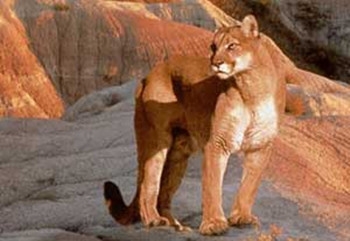
These holes are the unmistakable hallmark of a violent death. Their shape suggest they were made by the teeth of a big cat, but which one? Today there’s only one large cat in the region, the Florida panther. Though similar to the cougar at the western states, it's now much rarer. But it was around during the ice age, so could it have killed the glyptodont?
这些裂孔无疑出自一位猛烈的“死亡收割者”。从形状上看,他们出自一种大型猫科动物的牙齿,但是是哪一种呢?今天,在这片区域只存活着一种大型猫科动物——佛罗里达豹。尽管和西部各州的美洲狮有很多相似之处,但是他们却更为稀少。然而换作是在冰河时代,他们能杀死雕齿兽吗?
Although it could easily manage a deer, the Florida panther was probably too small to tackle such a giant. But it wasn't the only big cat around 13,000 years ago. There was also the mighty American lion, powerful enough to kill a glyptodont.
尽管能够轻易猎杀一只鹿,但是佛罗里达豹的体型却没有大到能够对付如此一个大型动物。但是在13000年以前,大型猫科动物的种类更多。例如大美洲狮,他们十分强大,杀死一只雕齿兽绰绰有余。
The scimitar-toothed cat, known to attack young mammonths, was also big and strong enough. And then there was the most infamous cat of all, the sabertooth. Like the scimitar, it saved its awesome fangs for slashing soft flesh. It would have been unlikely to risk breaking them on bony armor. But the warm climate of ice age Florida made it a sanctuary for another killer cat. Still South America's top predator, the jaguar is capable of taking prey much larger than itself. Weight for weight, it's probably the most powerful cat alive today.
这种牙齿呈月牙状的猫科动物经常捕杀年幼的猛犸象,他们体型巨大且十分强壮。而另一个例子就是鲜为人知的剑齿虎。和大美洲狮的月牙状牙齿一样,他们也有着长长的牙齿,并用此来撕扯柔软的肉。但要是用他们在撕咬骨盔也并不可行。然而温暖的气候使冰河时代的佛罗里达成为了另一种猫科“杀手”的避难所,这种猫科动物同样是南美州的顶层捕猎者——美洲虎,它们能够猎杀比自身体型大得多的动物。同样,它们也可能是当今存活的最为强大的猫科动物。
英文文本来自普特英语,译文属可可原创,仅供学习交流使用,未经许可不得转载.












